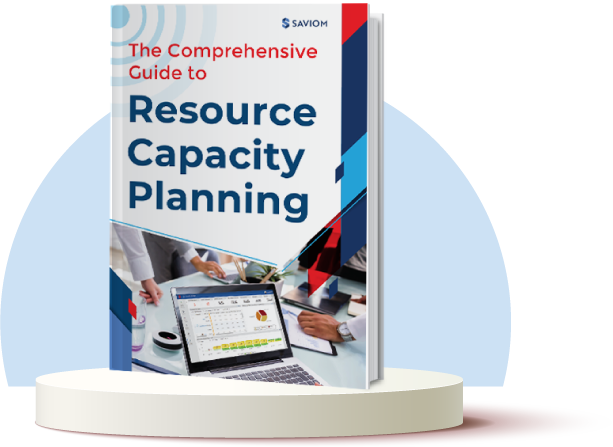Can you imagine meeting project deadlines without a suitable resource schedule? Certainly not. Projects are constrained by specific budgets and timelines, and their success relies on the intelligent use of resources. Thus, resource scheduling plays a vital role in successful project delivery. As per Mckinsey,
“83% of business leaders think resource scheduling is the top lever for spurring project growth.”
However, many companies still rely on silos of spreadsheets or homegrown half-baked tools, which are time-consuming and cumbersome.
Lack of enterprise-wide visibility, errors during data reconciliation, incapable of capturing real-time data, etc., are some of the limitations of using spreadsheets for resource scheduling. Improper resource allocation hampers profitability, resource utilization, and productivity. Moreover, it also affects client satisfaction and negates project success. That’s why businesses need to reconsider their resource management strategy and invest in a robust solution to overcome resource scheduling challenges.
This blog discusses the signs of poor resource scheduling and how modern resource management software can course-correct them.
Unable to leverage a shared services model
Suppose you have a resource requirement with 50% availability for your project. You will raise the request to the resource manager for this requirement. The resource manager knows that there are resources in the pool with matching skill sets. But they could be working on other projects with varying capacities. In the absence of enterprise-wide visibility of resources bookings, the resource manager cannot identify the right person. He may land up assigning a resource with 100% capacity. Unless the same resource can be partially allocated to another project, it will affect his billable utilization.
Solution: A 360-degree visibility of the resources in the organization
Modern resource management solution provides 360-degree visibility of all resources across all departments. It consolidates all resource-related information on a centralized platform and keeps you informed of their allocations and availability. One can also manage complex scheduling effortlessly by leveraging cost-effective global resources if required. This avoids double bookings and maintains a single version of the truth across the enterprise.
Read More: Resource Management: A Comprehensive Handbook for Project Managers
Insufficient productivity levels causing a high attrition rate
As a project manager, you want to get the task done in the shortest time possible and deliver the best possible results. So you select a few critical team members you have known from the past and give them additional responsibilities beyond their capacity. You start moving them between tasks, trying to utilize them to their full content, and more.
As a result, these resources get overloaded while other team members are not fully utilized. It leads to employee burnouts for the critical resources leading to unplanned attrition.
So how do you maintain overall productive utilization of all the resources without overburdening them?
Solution: Ensure optimal utilization of all resources
Managers can gain foresight into resource utilization and distribute the workload evenly without over or under-allocating resources. Besides, keeping team members busy with work doesn’t mean they are productive. They could be spending a lot of time doing mundane BAU activities. Therefore, the forecasting capability of an intuitive resource management solution enables managers to mobilize team members from non-billable/low-priority work to a billable/high-priority one and improve profitability.
Skill shortages due to a lack of foresight into future demand
Let’s assume that you are working on a big project and a new initiative is coming up in three months. But you do not know how many resources are required or if they are available. As a result, when the start date approaches, you have no choice but to resort to last-minute hiring activities. It compromises the resource quality and affects the delivery.
Solution: Switch to data-driven demand forecasting and capacity planning
One of the critical functions of resource management is demand forecasting that allows managers to gain complete visibility of current and future project demands. It helps identify resource excesses and shortages ahead of time and take appropriate resourcing treatments to mitigate them. Retraining resources or hiring a permanent or contingent workforce creates an optimally balanced and skilled resource pool. It reduces wasteful hiring/firing cycles and future-proofing the workforce.
Read More: What is Resource Capacity Planning? An Ultimate Guide for Every Project Manager
People are spending a lot of time attending meetings
Spending too much time in the meetings makes the resources less productive and increases time overruns. As per a survey by Korn Ferry,
“67% of workers say excessive meetings keep them from getting their best work done.”
When there are too many unnecessary meetings in a day, the employees can get frustrated. For example, let’s assume that in an 8-hour workday, you have scheduled four one-hour meetings. These meetings are to keep your team on the same page and also to monitor the progress. Each session is scheduled one hour after the other. Based on that, the resources will have four hours to attend meetings and four hours to focus on real work. Their actual working time will be significantly reduced, and delivery will be adversely affected.
Solution: Schedule meetings only when necessary
Before scheduling a meeting, one should consider the purpose of the meeting. What is the outcome that you expect at the end of the session? Moreover, most of the time, you may not invite too many people to the meeting. While collaboration is essential, not everyone needs to attend a meeting. Instead of having the whole team participate, only team leads can join, allowing others to focus and complete tasks on time.
Resource scheduling solution enables you to look at time-sheet data, and one can easily analyze if resources are spending too much time on mundane activities. The dashboard view will allow the management to verify that too much time is wasted in attending meetings. This can be course-corrected by providing the necessary direction to the project manager.
Read More: What is Resource Booking? A Comprehensive Guide for Managers
High employee turnover during the night shift
Night shift work requires people to work while most people are asleep. When it comes to night shift employees, it’s often harder to motivate them to stay. Working non-normal hours can be especially difficult for employees with families as they fail to strike the right work-life balance. Besides, the night shift disturbs the natural bio cycle of humans and takes a toll on their physical and mental health.
It would help if you kept in mind that the core of employee retention revolves around ensuring that your employees are happy at their job. While some people may enjoy working at night, the majority of employees do not. The person might have agreed to work on a night shift while accepting the offer, but it can force him to leave due to fatigue and constant sleep deprivation.
Solution: Induce rotating shifts for better flexibility
Workplace flexibility is more important than ever. Rotating work schedules can provide that flexibility for adjusting to the changing demands. With rotating shifts, employees can work the day shift for some weeks and then switch to working the night shift based on their needs. It helps keep the hours covered while still giving your employees regular time off.
Besides, when someone wants time off, you can make room for other critical tasks without interrupting workflow. You can even let your team swap shifts with others in their group. Moreover, rotating shifts help increase employee engagement as they can work at their preferred schedule. It also helps in training under-qualified members as everyone gets their share of working at peak hours.This kind of practice can be easily implemented using modern resource scheduling software.
Read More: What is Resource Scheduling? How to Schedule Resources for Projects Efficiently?
Clients hint at getting the same services at a lower cost
“Our requirements have not changed in a few years, and your workforce understands our business well. Because of our internal cost pressure, now we want the same service at a lesser cost.”
This is a common phrase sales reps hear from clients during the annual renewal of contracts. Globalization has also made the market highly competitive. That’s why clients have more options, and they are demanding quality services at a cheaper cost.
As a project manager, you want to adhere to the client’s needs. But offering a discount cuts into your profit margin and may also compromise the quality of the project.
What can you do to ensure successful project delivery and also stick to the client’s cost restraints?
Solution: Allocate low-cost global resources without compromising quality
Visibility across the enterprise enables you to identify and allocate cost-effective local and global resources by skills. If local resources for a particular skill set are not available, a multi-location policy helps leverage global resources from low-cost locations to do the job. It helps in reducing project resource costs significantly without compromising the quality.
Also, sometimes it becomes tough to do succession planning for a critical multi-skilled resource. If the role of such an employee needs to be distributed to multiple resources, the cost can go up substantially. This is, however, possible by distributing work with multiple people from a low-cost location. This way, one can prevent a single point of failure if this critical resource leaves the organization.
Read More: What is Resource Allocation? A Comprehensive Guide for Project Success
Lack of collaboration between team members
Let’s suppose that you have to develop a website for a client. To deliver this project, you need the web development, content, designing, and digital marketing departments to be on the same page. But as the project progresses, you notice that none of the members are aware of the other departments’ work. Moreover, you also don’t have any real-time report of the progress. Can you imagine creating this website without properly collaborating with the respective teams? Certainly not.
Solution: Improve interdepartmental collaboration
A resource management solution helps develop standardized communication procedures. A collaboration platform streamlines effective communication across the enterprise. With it, you can check activity updates or participate in the discussion board in a breeze. It also enables you to make notes, pin messages, and so on. Moreover, alerts and notifications displayed on the discussion board ensure you don’t miss any critical updates. Thus, you can ensure that everyone is on the same page.
Your project team lacks motivation
You have everything set for the project. You have your resources in line and have planned everything out. As the work progresses, you notice that your team lacks motivation. The supposed completion task in a month is now taking 2-3 months to complete. You pull up ways to overcome these resource management challenges, but your staff isn’t as energized as during the initial stage. So, what can you do to increase their motivation?
Solution: Boost employee morale and employee engagement
As mentioned earlier, taking employee’s skills and interests into consideration while assigning them to projects improves task ownership and engagement. Managers can publish the resource requirements, and interested employees matching the criteria can apply.
Besides resource scheduling, giving employees continuous feedback lets them know that you value their work and want them to prosper. Also, creating team-building activities such as games and friendly competition relax your team members.
Read More: Employee Recognition Programs: Types, Benefits and Best Practices
Conclusion- Resource Scheduling Tips
Resource scheduling enhances business profitability and sustainability by unleashing the maximum potential of resources. Here are some tips for efficient resource scheduling:
- Stay updated with resource availability, capacity, and utilization before scheduling more projects.
Analyze the capacity vs. demand gap in advance and implement appropriate resourcing measures to bridge the gap. - Use scheduling tactics to filter and search for the right resource for the right job.
- Foresee future project demands to ensure systematic management of pipeline projects.
- Conduct upskilling and training programs for resources to allow them to take up more opportunities down the line.
- Schedule resources for different functional projects that enable and empower them to explore new areas and grow professionally.
- Compare actual vs. forecast utilization and note the deviation to improve resource scheduling for future projects.
The Glossary
Read More: Glossary of Resource Workforce Planning, Scheduling and Management
SAVIOM Solution
SAVIOM has over 20 years of experience helping multinational clients manage their resources efficiently and effectively. With over 20 years of experience, this Australian-based MNC has a global presence across 50 countries and has helped 100+ clients meet their specific business goals. Saviom also provides tools for project portfolio management, professional service automation, and workforce planning software. So, SAVIOM can help your business to establish an efficient system geared towards your specific business challenges.











Leave a Reply